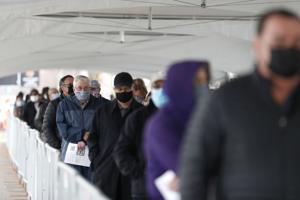Wisconsin vaccine numbers plateau, gap continues

(The Center Square) – Wisconsin’s Department of Health Services is attempting to get more people to take the coronavirus vaccine, but much of what they are doing isn’t working.
“We’re on a plateau,” DHS Deputy Secretary Julie Willems Van Dijk told reporters Tuesday.
About 43% of people in Wisconsin have gotten at least one dose of the vaccine, DHS says 35% of people in the state have gotten both doses. That’s where those numbers have been for a while. Vaccine dose distribution in the state fell by 200,000 doses last week, down to about 225,000 doses.
“We are making progress, and each dose gets us closer,” Willems Van Dijk said. “We are doing all we can to get people vaccinated.”
That includes opening many vaccine clinics in the state to walk-ins, and starting a new program to bring vaccine doses to community groups and local organizations across the state. It’s an expansion of the program that saw DHS take vaccines to offices and other workplaces.
“We don’t know what the number is that will result in the stalling out of infections.” Willems Van Dijk said. “We need to be less obsessed about the numbers on herd immunity, and more focused on the value of continuing to increase vaccinations.”
Willems Van Dijk said about 2.1 million in the state have not gotten their first dose. And many of them are not in a hurry to get it either.
“We are now talking with people who may certainly be interested in getting a vaccine, but it’ll be on their own schedule, their own timetable,” Willems Van Dijk added.
DHS has been targeting those people, many of them in the state’s black and Latino neighborhoods, for months. But many of the people in those neighborhoods are not getting the shot.
DHS’ numbers show most of the people who’ve gotten one dose of the vaccine, about 40% of them, are white. Only about 26% are Hispanic, and just over 20% are black.
Most of the vaccinated in Wisconsin are also older. DHS reports that 81% of people 65-plus have gotten one dose, compared to a third of people between 18 and 24.
Willems Van Dijk said that makes some sense.
“The people who felt most at risk, are likely the people who’ve most likely received their vaccine,” she said.
Disclaimer: This content is distributed by The Center Square

